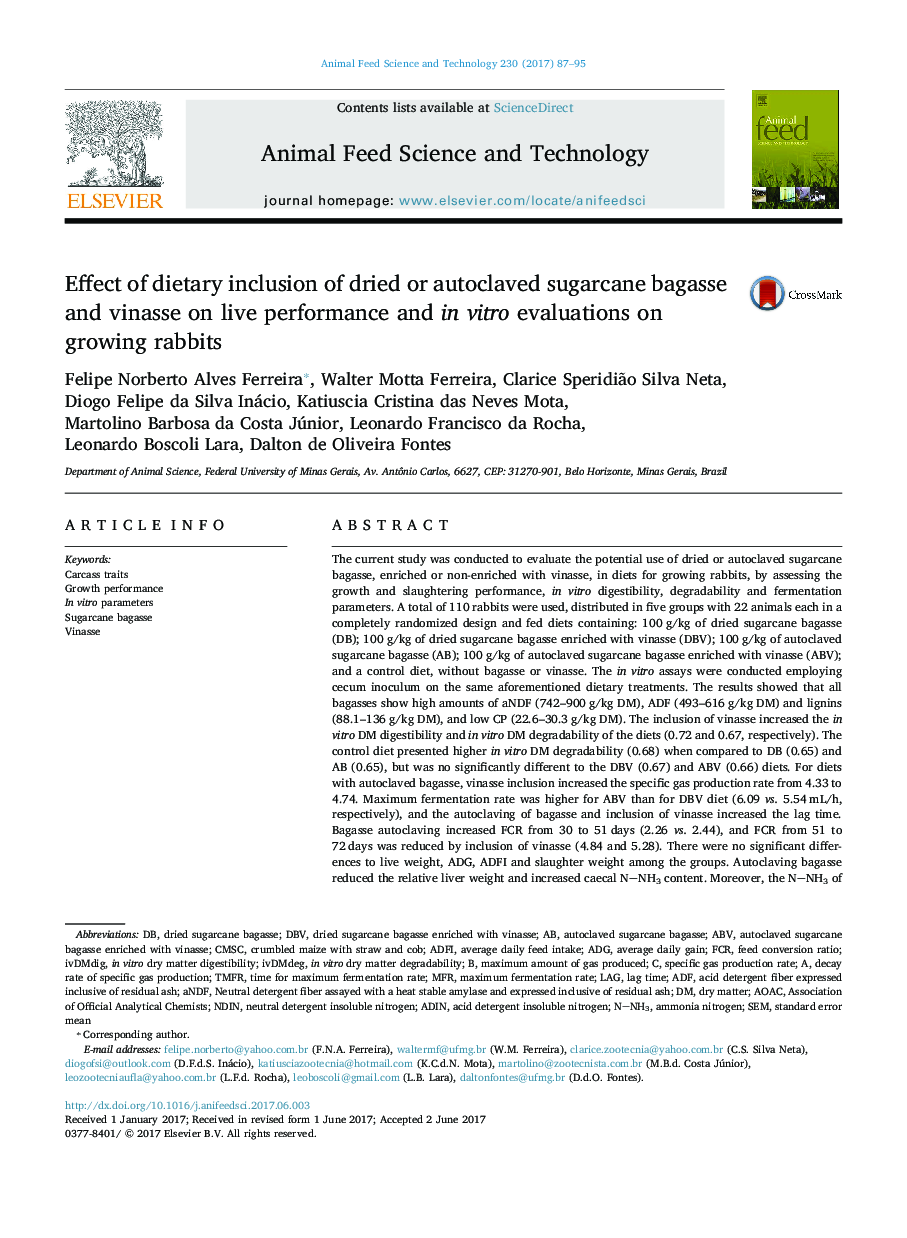| Article ID | Journal | Published Year | Pages | File Type |
|---|---|---|---|---|
| 5538702 | Animal Feed Science and Technology | 2017 | 9 Pages |
Abstract
The current study was conducted to evaluate the potential use of dried or autoclaved sugarcane bagasse, enriched or non-enriched with vinasse, in diets for growing rabbits, by assessing the growth and slaughtering performance, in vitro digestibility, degradability and fermentation parameters. A total of 110 rabbits were used, distributed in five groups with 22 animals each in a completely randomized design and fed diets containing: 100Â g/kg of dried sugarcane bagasse (DB); 100Â g/kg of dried sugarcane bagasse enriched with vinasse (DBV); 100Â g/kg of autoclaved sugarcane bagasse (AB); 100Â g/kg of autoclaved sugarcane bagasse enriched with vinasse (ABV); and a control diet, without bagasse or vinasse. The in vitro assays were conducted employing cecum inoculum on the same aforementioned dietary treatments. The results showed that all bagasses show high amounts of aNDF (742-900Â g/kg DM), ADF (493-616Â g/kg DM) and lignins (88.1-136Â g/kg DM), and low CP (22.6-30.3Â g/kg DM). The inclusion of vinasse increased the in vitro DM digestibility and in vitro DM degradability of the diets (0.72 and 0.67, respectively). The control diet presented higher in vitro DM degradability (0.68) when compared to DB (0.65) and AB (0.65), but was no significantly different to the DBV (0.67) and ABV (0.66) diets. For diets with autoclaved bagasse, vinasse inclusion increased the specific gas production rate from 4.33 to 4.74. Maximum fermentation rate was higher for ABV than for DBV diet (6.09 vs. 5.54Â mL/h, respectively), and the autoclaving of bagasse and inclusion of vinasse increased the lag time. Bagasse autoclaving increased FCR from 30 to 51Â days (2.26 vs. 2.44), and FCR from 51 to 72Â days was reduced by inclusion of vinasse (4.84 and 5.28). There were no significant differences to live weight, ADG, ADFI and slaughter weight among the groups. Autoclaving bagasse reduced the relative liver weight and increased caecal NNH3 content. Moreover, the NNH3 of the control group (3.71Â mmol/L) was lower than DBV (4.64Â mmol/L), AB (5.01Â mmol/L) and ABV (5.11Â mmol/L), but similar to the DB group (4.05Â mmol/L). The results of this study revealed that 100Â g/kg of sugarcane bagasse can be included in the diet of growing rabbits without adverse effects on growth performance. Additionally, autoclaving and vinasse inclusion promote higher rate and extent of in vitro digestion, which is reflected on the caecal activity.
Keywords
ADFABVaNDFADGCMSCADFIMFRAOACDBVFCRNDINADINAmmonia Nitrogenacid detergent fiber expressed inclusive of residual ashassociation of official analytical chemistsSugarcane bagasseLagstandard error meanLag timeCarcass traitsGrowth performanceNeutral detergent fiber assayed with a heat stable amylase and expressed inclusive of residual ashdry matteraverage daily gainSEMAverage daily feed intakefeed conversion ratioacid detergent insoluble nitrogenneutral detergent insoluble nitrogenIn vitro dry matter digestibilityVinasse
Related Topics
Life Sciences
Agricultural and Biological Sciences
Animal Science and Zoology
Authors
Felipe Norberto Alves Ferreira, Walter Motta Ferreira, Clarice Speridião Silva Neta, Diogo Felipe da Silva Inácio, Katiuscia Cristina das Neves Mota, Martolino Barbosa da Costa Júnior, Leonardo Francisco da Rocha, Leonardo Boscoli Lara,
